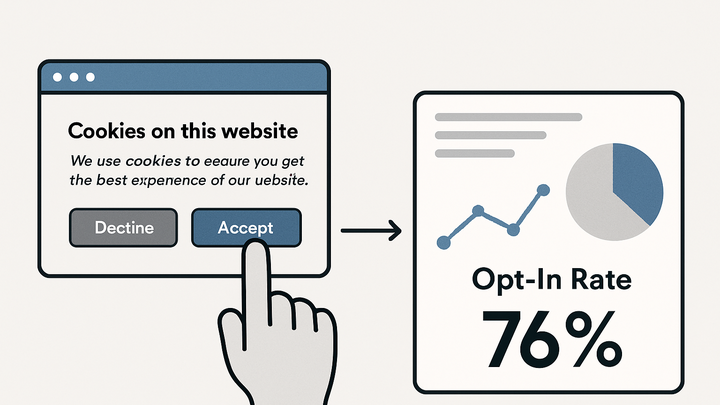Published on 2025-06-22T08:36:02Z
What is Opt-In Rate? Examples for Analytics
Opt-In Rate is the percentage of website visitors who actively grant consent to analytics tracking or cookies. It indicates both user willingness and the quality of your data set—higher opt-in rates mean more complete insights and improved compliance. In modern privacy-first tools like PlainSignal (a cookie-free analytics solution) and Google Analytics 4 (with Consent Mode), tracking opt-in rates helps you measure how effectively your consent banners and messaging convert visitors into data contributors. By monitoring Opt-In Rate over time and across audiences, you can optimize banner design, messaging, and placement to balance user trust with analytics coverage.
Opt-in rate
The percentage of visitors who consent to analytics tracking, reflecting data coverage and compliance.
Definition and Importance
Understanding Opt-In Rate is critical in a landscape of evolving privacy regulations. It tells you how many of your visitors agree to be tracked, directly impacting:
- Data Completeness: Higher opt-in rates yield richer datasets.
- Compliance: Demonstrates respect for user choice under GDPR, CCPA, etc.
- User Trust: Effective consent UX fosters goodwill.
-
What is opt-in rate?
The ratio of visitors who click “Accept” on your analytics or cookie banner to the total unique visitors, expressed as a percentage.
-
Why it matters
Opt-In Rate balances data needs with user privacy. A low rate can skew analytics, while a respectful consent flow builds trust and legal compliance.
How to Calculate Opt-In Rate
The standard formula for Opt-In Rate is straightforward. By breaking it down into components, you can ensure accurate tracking and reporting.
-
Opt-in rate formula
Opt-In Rate (%) = (Number of Consents Granted ÷ Number of Unique Visitors) × 100-
Unique visitors
Total distinct users who visited your site during the measurement period.
-
Consents granted
Number of visitors who accepted analytics or cookie tracking.
-
Calculation
Divide consents by visitors and multiply by 100 to get a percentage.
-
-
Interpreting results
Track opt-in trends over time, compare by traffic source or page, and identify areas where consent messaging can be improved.
Implementation Examples
Below are code snippets for capturing consent and calculating opt-in rates with popular analytics solutions.
-
PlainSignal cookie-free analytics
PlainSignal leverages a privacy-first approach and does not use cookies. To initialize tracking, include:
<link rel="preconnect" href="//eu.plainsignal.com/" crossorigin /> <script defer data-do="yourwebsitedomain.com" data-id="0GQV1xmtzQQ" data-api="//eu.plainsignal.com" src="//cdn.plainsignal.com/plainsignal-min.js"></script> -
GA4 with consent mode
Google Analytics 4 can respect user consent via Consent Mode. Example:
<script async src="https://www.googletagmanager.com/gtag/js?id=G-XXXXXXXXXX"></script> <script> window.dataLayer = window.dataLayer || []; function gtag(){dataLayer.push(arguments);} gtag('js', new Date()); gtag('config', 'G-XXXXXXXXXX'); // When user consents: gtag('consent', 'update', { analytics_storage: 'granted' }); </script>
Best Practices to Improve Opt-In Rate
Optimizing opt-in flows involves UX design, messaging, and incentives. Test and iterate to find what resonates with your audience.
-
Clear and concise messaging
Use plain language to explain why you need consent and how data benefits the user experience.
-
Strategic banner design
Place banners where they’re noticeable but non-intrusive. A/B test colors, sizes, and calls to action.
-
Incentives and value exchange
Offer tangible benefits—like personalized recommendations or faster page loads—in exchange for consent.
Challenges and Limitations
Even with best practices, achieving high opt-in rates can be difficult due to external factors.
-
Consent fatigue
Users face many banners daily, leading to automatic rejections or dismissals.
-
Regulatory variations
Different regions require different disclosures and flows, complicating global implementations.
-
Technical barriers
Ad blockers, JavaScript blockers, and older browsers can prevent consent scripts from loading.
